New Expressions to Apply the Variation Operation Strategy in Engineering Tools Using Pumps Working as Turbines
Abstract
1. Introduction
2. Materials and Methods
2.1. Methodology
- Obtaining experimental characteristic curves of the PATs. The characteristic curves (i.e., head, efficiency, and power curve) were made available for the different machines using experimental data which were published by other researchers. Both the nominal curve and the curves for different rotational speeds were digitized using Equations (1)–(3).
- Definition of the dimensionless values of the curve to apply the affinity laws. This is developed using the previously defined equations (Equations (4)–(8)). When the affinity laws are applied, the congruence parabola is defined by the following equation [29]:where is the new flow rate in m3/s in which the machine has to operate. is a parabola, which has the same efficiency at each point. This consideration is theoretical, since (in practice) it is only acceptable for values around +/−20% of the best efficiency point of the machine [29]. This variation in the rotational speed of the machine is defined by the ratio between the rotational speed () of the machine to reach the value () and the nominal rotational speed (). This ratio between and is called .
- 3.
- Once the dimensionless parameters () are defined, the best efficiency curve (BEH) of the machine is determined. BEH is the curve which establishes the recovered head for each flow, maximizing efficiency and changing the rotation speed of the machine. This curve is defined in [27].
- 4.
- When the BEH is known for each machine, the ratio is defined for the different values, using the experimental data as well as the regression of the different head and efficiency curves. This parameter is defined for each rotational speed of the machine. The rotational speed varies between the and of the VOS. The operation area is defined by the maximum and minimum rotational speed, determined by the tested machine.
- 5.
- In [27,31], variations of the affinity laws are proposed, where the flow ratio ( is a function that depends on ; taking into account this modification of the affinity laws, the corresponding parameter for the modified affinity laws (MOAL) can be defined when the affinity laws are modified by the following expression:
- 6.
- The value of the coefficient is defined for the different rotational speeds of the machine, determining the cut-off point with the hypothetical head surface and machine efficiency (Figure 2).
- 7.
- Once the non-dimensional parameters for the different rotational speeds are defined, the regression expressions are proposed. These functions depend on rotational speed (), which is a significant variable [31] when the non-dimensional parameters are defined (i.e., ). Moreover, different expressions are also proposed considering the ratio . This parameter is considered since it measures the gap between the flow value and the flow for the best efficiency point. The incorporation of this parameter will improve the regression coefficient of the expressions, as well as reducing the errors. The modified affinity laws are then defined according to different expressions:
- 8.
- This step is related to the previous step and concerns the recalculation of the coefficients considering the values of all the tested machines . The sub-index “m” refers to each tested machine.
- 9.
- Having the coefficients for the different functions () as well as the non-dimensional parameters ) defined, the errors of the proposed functions by MOAL are calculated. The error indices considered were root mean square error (RMSE), mean absolute deviation (MAD), the mean relative deviation (MRD), and BIAS:
- (a)
- RMSE. This error index measures the error between the empirical expression and experimental values. When RMSE is zero, this value indicates a perfect fit. It is defined by (24):where are the estimated values; the experimental values, and x is the number of observations.
- (b)
- MAD. This index measures the average of the errors in the estimated values, using the absolute differences between estimated and experimental values. The perfect fit is defined when MAD is zero, and it is defined by the following expression (25):
- (c)
- MRD. This index considers the weight of the error to the variable value. If MRD is zero, this value indicates a perfect fit. Formally, it is defined as follows (26):
- (d)
- BIAS. The index considers the variable tendency, analyzing whether the estimated values are greater (negative value) or smaller (positive value) than experimental values. It is defined by the following expression (27):
2.2. Materials
3. Results
3.1. Proposed Function Models
3.2. Error Distribution Compared to Rotational Speed
3.3. Proposed Functions vs. Other Published Functions
4. Conclusions
Author Contributions
Funding
Institutional Review Board Statement
Informed Consent Statement
Data Availability Statement
Conflicts of Interest
References
- Mangalekar, R.D.; Gumaste, K.S. Residential water demand modelling and hydraulic reliability in design of building water supply systems: A review. Water Supply 2021. [Google Scholar] [CrossRef]
- Bach, P.M.; Rauch, W.; Mikkelsen, P.S.; McCarthy, D.T.; Deletic, A. A critical review of integrated urban water modelling–Urban drainage and beyond. Environ. Model Softw. 2014, 54, 88–107. [Google Scholar] [CrossRef]
- Mousavi, S.N.; Bocchiola, D. A novel comparative statistical and experimental modeling of pressure field in free jumps along the apron of USBR Type I and II dissipation basins. Mathematics 2020, 8, 2155. [Google Scholar] [CrossRef]
- Raboaca, M.S.; Bizon, N.; Trufin, C.; Enescu, F.M. Efficient and secure strategy for energy systems of interconnected farmers′ associations to meet variable energy demand. Mathematics 2020, 8, 2182. [Google Scholar] [CrossRef]
- Puust, R.; Kapelan, Z.; Savic, D.A.; Koppel, T. A review of methods for leakage management in pipe networks. Urban Water J. 2010, 7, 25–45. [Google Scholar] [CrossRef]
- Vakilifard, N.; Anda, M.; Bahri, P.A.; Ho, G. The role of water-energy nexus in optimising water supply systems—Review of techniques and approaches. Renew. Sustain. Energy Rev. 2018, 82, 1424–1432. [Google Scholar] [CrossRef]
- Orouji, H.; Bozorg Haddad, O.; Fallah-Mehdipour, E.; Mariño, M.A. Modeling of water quality parameters using data-driven models. J. Environ. Eng. 2013, 139, 947–957. [Google Scholar] [CrossRef]
- Ramos, H.; Borga, A. Pumps as turbines: An unconventional solution to energy production. Urban Water 1999, 1, 261–263. [Google Scholar] [CrossRef]
- García, I.F.; Novara, D.; Mc Nabola, A. A model for selecting the most cost-effective pressure control device for more sustainable water supply networks. Water 2019, 11, 1297. [Google Scholar] [CrossRef]
- Pérez-Sánchez, M.; Sánchez-Romero, F.J.; Ramos, H.M.; López-Jiménez, P.A. Improved planning of energy recovery in water systems using a new analytic approach to PAT performance curves. Water 2020, 12, 468. [Google Scholar] [CrossRef]
- Pérez-Sánchez, M.; Sánchez-Romero, F.; Ramos, H.; López-Jiménez, P. Energy recovery in existing water networks: Towards greater sustainability. Water 2017, 9, 97. [Google Scholar] [CrossRef]
- Fecarotta, O.; Aricò, C.; Carravetta, A.; Martino, R.; Ramos, H.M. Hydropower Potential in Water Distribution Networks: Pressure Control by PATs. Water Resour Manag. 2015, 29, 699–714. [Google Scholar] [CrossRef]
- Quaranta, E.; Bonjean, M.; Cuvato, D.; Nicolet, C.; Dreyer, M.; Gaspoz, A.; Rey-Mermet, S.; Boulicaut, B.; Pratalata, L.; Pinelli, M.; et al. Hydropower case study collection: Innovative low head and ecologically improved turbines, hydropower in existing infrastructures, hydropeaking reduction, digitalization and governing systems. Sustainability 2020, 12, 8873. [Google Scholar] [CrossRef]
- Carravetta, A.; Conte, M.C.; Fecarotta, O.; Ramos, H.M. Evaluation of PAT performances by modified affinity law. Procedia Eng. 2014, 89, 581–587. [Google Scholar] [CrossRef]
- Suter, P. Representation of pump characteristics for calculation of water hammer. Sulzer Tech. Rev. 1966, 66, 45–48. [Google Scholar]
- Kougias, I.; Aggidis, G.; Avellan, F.; Deniz, S.; Lundin, U.; Moro, A.; Muntean, S.; Novara, D.; Perez-Diaz, J.I.; Quaranta, E.; et al. Analysis of emerging technologies in the hydropower sector. Renew. Sustain. Energy Rev. 2019, 113, 109257. [Google Scholar] [CrossRef]
- Novara, D.; McNabola, A. A model for the extrapolation of the characteristic curves of Pumps as Turbines from a datum best efficiency point. Energy Convers. Manag. 2018, 174, 1–7. [Google Scholar] [CrossRef]
- Shah, S.R.; Jain, S.V.; Patel, R.N.; Lakhera, V.J. CFD for centrifugal pumps: A review of the state-of-the-art. Procedia Eng. 2013, 51, 715–720. [Google Scholar] [CrossRef]
- Carravetta, A.; Del Giudice, G.; Fecarotta, O.; Ramos, H. Pump as Turbine (PAT) design in water distribution network by system effectiveness. Water 2013, 5, 1211–1225. [Google Scholar] [CrossRef]
- Iliev, I.; Trivedi, C.; Dahlhaug, O.G. Variable-speed operation of Francis turbines: A review of the perspectives and challenges. Renew. Sustain. Energy Rev. 2019, 103, 109–121. [Google Scholar] [CrossRef]
- Singh, P. Optimization of the Internal Hydraulic and of System Design in Pumps as Turbines with Field Implementation and Evaluation. Ph.D. Thesis, Karlsruhe Institute of Technology, Karlsruhe, Germany, 3 June 2005. [Google Scholar]
- Yang, S.S.; Derakhshan, S.; Kong, F.Y. Theoretical, numerical and experimental prediction of pump as turbine performance. Renew. Energy 2012, 48, 507–513. [Google Scholar] [CrossRef]
- Rossi, M.; Nigro, A.; Renzi, M. Experimental and numerical assessment of a methodology for performance prediction of Pumps-as-Turbines (PaTs) operating in off-design conditions. Appl. Energy 2019, 248, 555–566. [Google Scholar] [CrossRef]
- Novara, D.; Carravetta, A.; McNabola, A.; Ramos, H.M. Cost model for pumps as turbines in run-of-river and in-pipe microhydropower applications. J. Water Resour. Plan. Manag. 2019, 145, 04019012. [Google Scholar] [CrossRef]
- Derakhshan, S.; Nourbakhsh, A. Experimental study of characteristic curves of centrifugal pumps working as turbines in different specific speeds. Exp. Therm. Fluid Sci. 2008, 32, 800–807. [Google Scholar] [CrossRef]
- Carravetta, A.; del Giudice, G.; Fecarotta, O.; Ramos, H. PAT design strategy for energy recovery in water distribution networks by electrical regulation. Energies 2013, 6, 411–424. [Google Scholar] [CrossRef]
- Pérez-Sánchez, M.; López-Jiménez, P.A.; Ramos, H.M. Modified affinity laws in hydraulic machines towards the best efficiency line. Water Resour. Manag. 2018, 32, 829–844. [Google Scholar] [CrossRef]
- Tahani, M.; Kandi, A.; Moghimi, M.; Houreh, S.D. Rotational speed variation assessment of centrifugal pump-as-turbine as an energy utilization device under water distribution network condition. Energy 2020, 213, 118502. [Google Scholar] [CrossRef]
- Mataix, C. Turbomáquinas Hidráulicas; Universidad Pontificia Comillas: Madrid, Spain, 2009. [Google Scholar]
- Morrison, G.; Yin, W.; Agarwal, R.; Patil, A. Development of modified affinity law for centrifugal pump to predict the effect of viscosity. J. Sol. Energy Eng. Trans. ASME. 2018, 140. [Google Scholar] [CrossRef]
- Fecarotta, O.; Carravetta, A.; Ramos, H.M.; Martino, R. An improved affinity model to enhance variable operating strategy for pumps used as turbines. J. Hydraul. Res. 2016, 1686, 1–10. [Google Scholar] [CrossRef]
- KSB. PATs Curves. Catalogue. Available online: https://www.ksb.com/ksb-en/ (accessed on 5 November 2019).
- Jain, S.V.; Swarnkar, A.; Motwani, K.H.; Patel, R.N. Effects of impeller diameter and rotational speed on performance of pump running in turbine mode. Energy Convers. Manag. 2015, 89, 808–824. [Google Scholar] [CrossRef]
- Nygren, L. Hydraulic Energy Harvesting with Variable-Speed-Driven Centrifugal Pump as Turbine. Ph.D. Thesis, Lappeenrtanta University of Technology, Lappeenranta, Finland, 2017. [Google Scholar]
- Abazariyan, S.; Rafee, R.; Derakhshan, S. Experimental study of viscosity effects on a pump as turbine performance. Renew. Energy 2018, 127, 539–547. [Google Scholar] [CrossRef]
- Kramer, M.; Terheiden, K.; Wieprecht, S. Pumps as turbines for efficient energy recovery in water supply networks. Renew. Energy 2018, 122, 17–25. [Google Scholar] [CrossRef]
- Delgado, J.; Ferreira, J.P.; Covas, D.I.C.; Avellan, F. Variable speed operation of centrifugal pumps running as turbines. Experimental investigation. Renew. Energy 2019, 142, 437–450. [Google Scholar] [CrossRef]
- Stefanizzi, M.; Torresi, M.; Fortunato, B.; Camporeale, S.M. Experimental investigation and performance prediction modeling of a single stage centrifugal pump operating as turbine. Energy Procedia 2017, 126, 589–596. [Google Scholar] [CrossRef]
- Postacchini, M.; Darvini, G.; Finizio, F.; Pelagalli, L.; Soldini, L.; Di Giuseppe, E. Hydropower generation through Pump as Turbine: Experimental study and potential application to small-scale WDN. Water 2020, 12, 958. [Google Scholar] [CrossRef]
- Pugliese, F.; De Paola, F.; Fontana, N.; Giugni, M.; Marini, G. Experimental characterization of two Pumps as Turbines for hydropower generation. Renew. Energy 2016, 99, 180–187. [Google Scholar] [CrossRef]
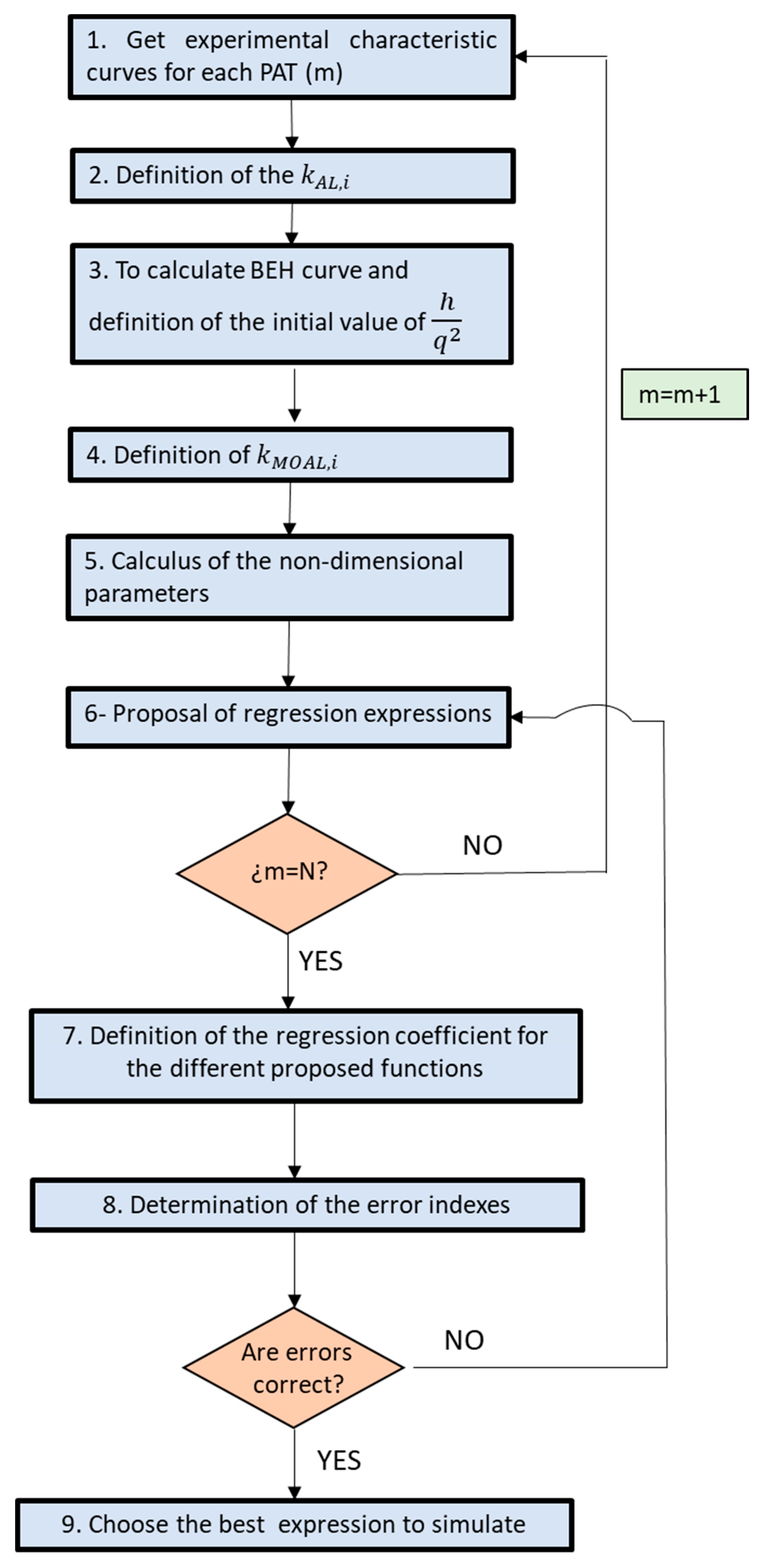

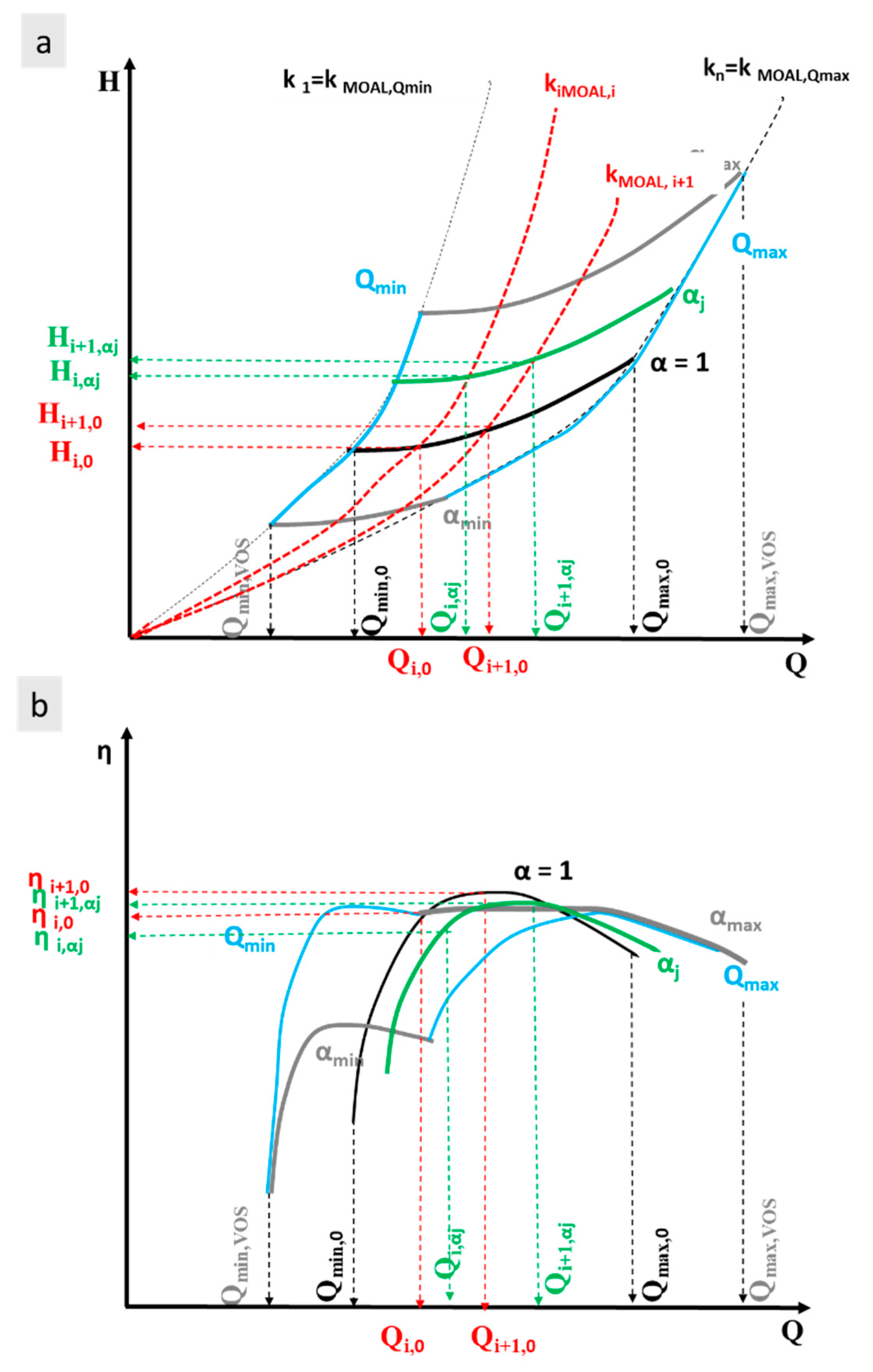
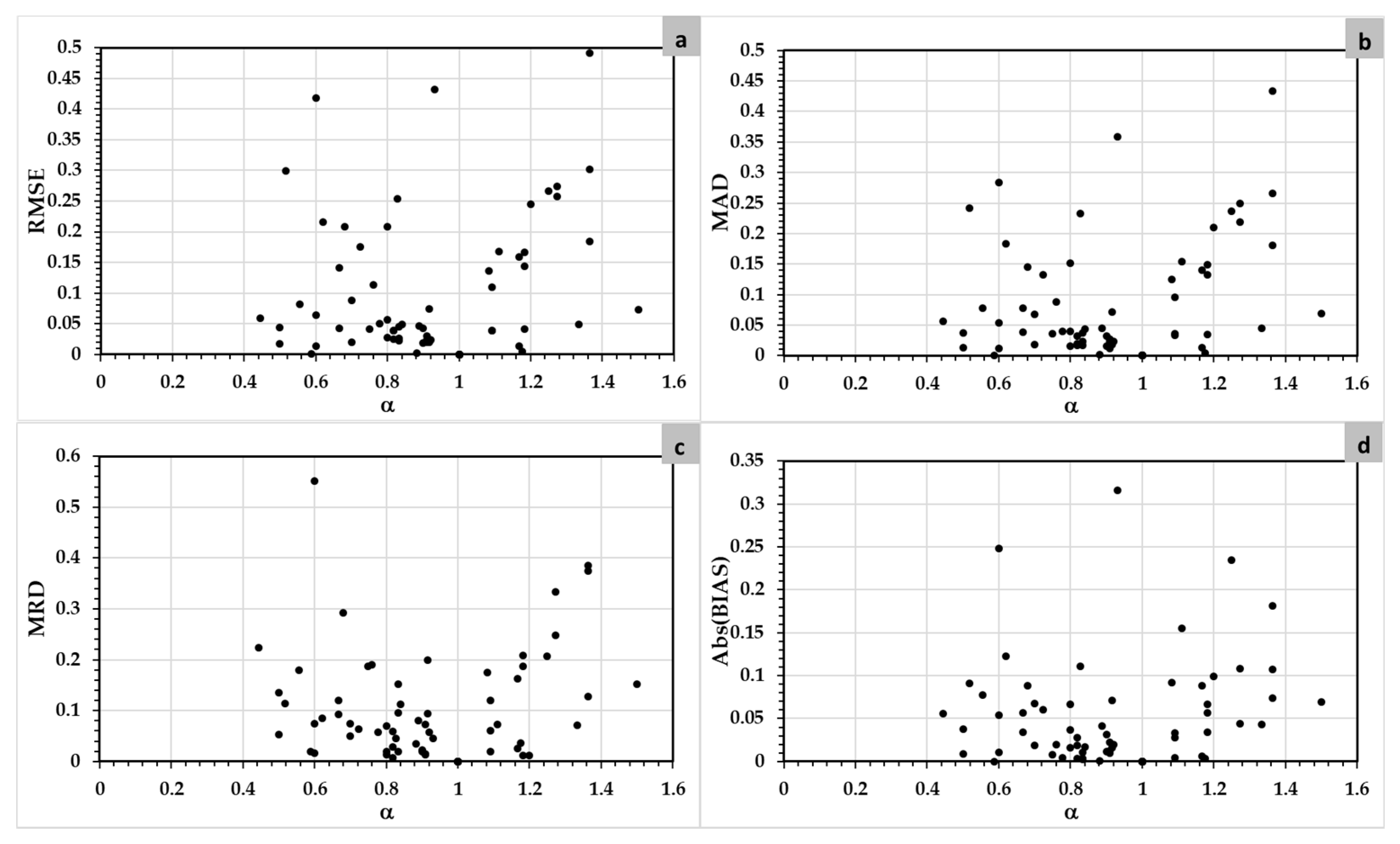
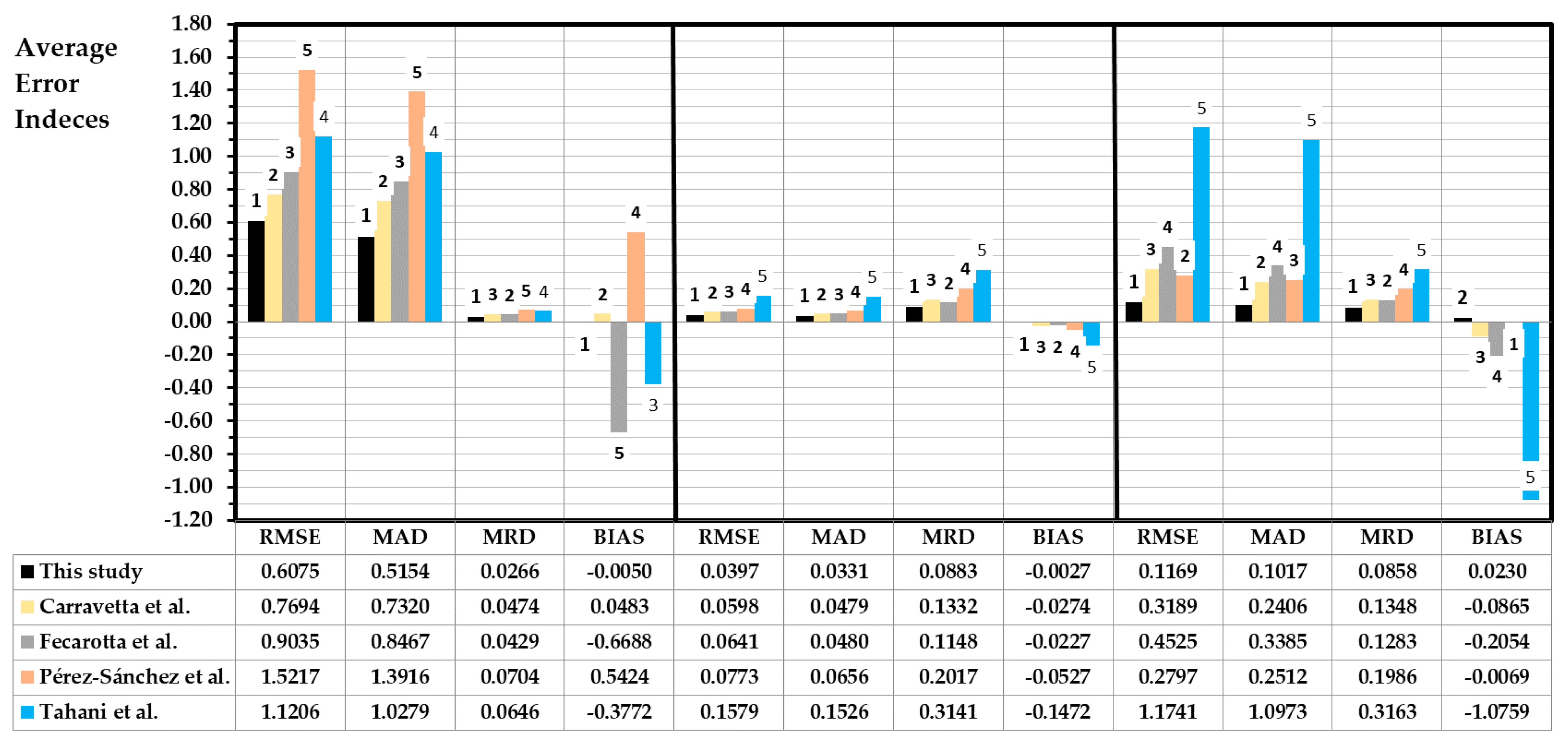
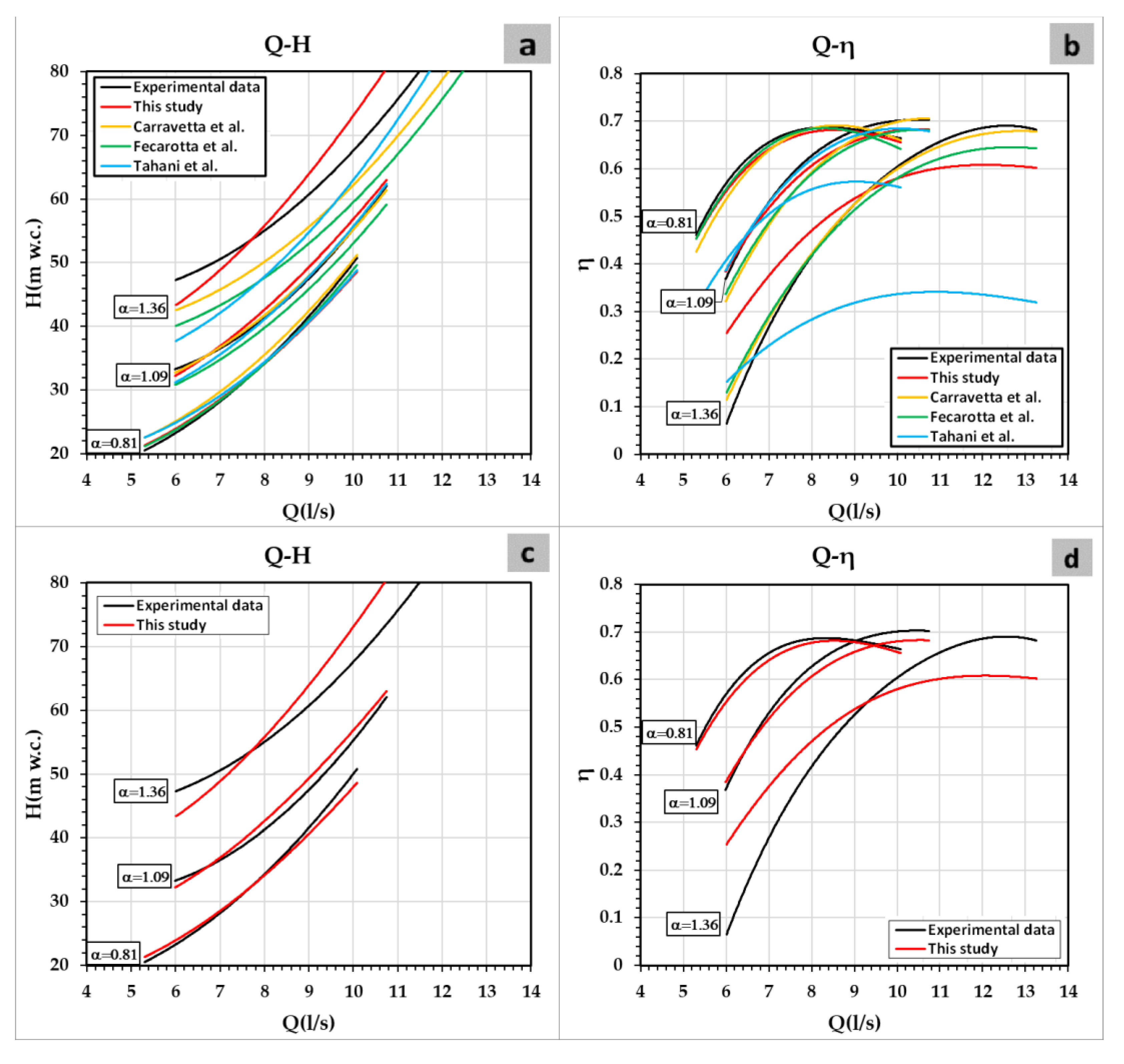
| Function Model (FM) | |
|---|---|
| ID | Ref. | D (mm) | (m w.c.) | RS | IP | AP | ||||
|---|---|---|---|---|---|---|---|---|---|---|
| 1 | [32] | 20.66 | 1020 | 139 | 3461 | 4144 | 0.615 | 4 | 766 | 2393 |
| 2 | [33] | 28.34 | 1200 | 200 | 24,460 | 12,437 | 0.596 | 7 | 621 | 3812 |
| 3 | 25.57 | 1100 | 225 | 22,295 | 11,941 | 0.714 | 7 | 851 | 5646 | |
| 4 | 26.43 | 1100 | 250 | 23,731 | 11,910 | 0.766 | 7 | 766 | 5086 | |
| 5 | [34] | 17.68 | 1200 | 210 | 16,755 | 18,126 | 0.718 | 6 | 846 | 4377 |
| 6 | 27.03 | 800 | 265 | 27,322 | 8305 | 0.800 | 5 | 680 | 2997 | |
| 7 | 25.44 | 1200 | 255 | 28,392 | 15,859 | 0.715 | 6 | 580 | 3035 | |
| 8 | [35] | 13.65 | 1200 | 139 | 4906 | 11,283 | 0.543 | 3 | 714 | 1937 |
| 9 | [36] | 5.67 | 1100 | 193 | 9762 | 51,267 | 0.703 | 6 | 680 | 3514 |
| 10 | [37] | 31.16 | 3000 | 127 | 17,985 | 30,288 | 0.695 | 6 | 802 | 4535 |
| 11 | 20.97 | 3000 | 158 | 17,975 | 51,355 | 0.727 | 6 | 777 | 4516 | |
| 12 | 50.71 | 2700 | 127 | 36,909 | 22,207 | 0.705 | 7 | 609 | 4139 | |
| 13 | [38] | 21.75 | 1000 | 419 | 95,591 | 34,428 | 0.795 | 4 | 745 | 2595 |
| 14 | [39] | 13.84 | 1250 | 175 | 8990 | 17,525 | 0.622 | 6 | 804 | 3020 |
| 15 | [40] | 33.1 | 2900 | 189 | 50,050 | 52,849 | 0.646 | 7 | 708 | 4848 |
| Total | 87 | 10,949 | 56,450 | |||||||
| q | p | ||||||||||||||
| FM | R2 | FM | R2 | ||||||||||||
| 0.9945 | -- | -- | -- | −0.4603 | 1.4250 | -- | 0.9133 | -- | -- | -- | 0.4447 | 0.4063 | -- | ||
| 0.8630 | -- | -- | -- | −0.7538 | 2.0117 | −0.2765 | 0.6836 | -- | -- | -- | −0.8423 | 2.9793 | −1.2124 | ||
| 0.9955 | -- | 0.1112 | -- | −0.4566 | 1.3510 | -- | 0.9244 | -- | 0.3783 | -- | 0.4574 | 0.1547 | -- | ||
| 0.8802 | -- | 0.0925 | -- | −0.6867 | 1.8224 | −0.2163 | 0.7109 | -- | 0.2897 | -- | −0.6325 | 2.3865 | −1.0239 | ||
| 0.9956 | −0.0109 | 0.2984 | −0.2918 | −0.5549 | 1.5705 | -- | 0.9357 | 2.0926 | 0.4300 | −2.2315 | −1.0984 | 1.8245 | -- | ||
| 0.8809 | −0.1525 | 0.1958 | −0.0118 | −0.6429 | 1.8489 | −0.2241 | 0.7297 | 1.6724 | 0.1255 | −1.4005 | −1.3596 | 2.6509 | −0.6651 | ||
| 0.8310 | -- | -- | -- | -- | 0.7439 | -- | 0.8098 | -- | -- | -- | -- | 2.4762 | -- | ||
| 0.8243 | -- | -- | -- | -- | 0.6796 | −0.0540 | 0.8019 | -- | -- | -- | -- | 2.2406 | −0.1978 | ||
| 0.8949 | -- | -- | 0.1847 | -- | 0.5541 | -- | 0.8825 | -- | -- | 0.6644 | -- | 1.7937 | -- | ||
| 0.8567 | -- | -- | 0.1675 | -- | 0.5617 | −0.0085 | 0.8374 | -- | -- | 0.5858 | -- | 1.8282 | −0.0388 | ||
| h | h/q2 | ||||||||||||||
| FM | R2 | FM | R2 | ||||||||||||
|---|---|---|---|---|---|---|---|---|---|---|---|---|---|---|---|
| 0.9910 | -- | -- | -- | 0.5072 | 0.4588 | -- | 0.9781 | -- | -- | -- | −0.5118 | 1.6305 | -- | ||
| 0.9474 | -- | -- | -- | 0.0943 | 1.2844 | −0.3890 | 0.7375 | -- | -- | -- | 1.0476 | −1.4870 | 1.4690 | ||
| 0.9919 | -- | 0.1161 | -- | 0.5111 | 0.3816 | -- | 0.9811 | -- | −0.2347 | -- | −0.5196 | 1.7866 | -- | ||
| 0.9506 | -- | 0.0874 | -- | 0.1576 | 1.1055 | −0.3321 | 0.7639 | -- | −0.1139 | -- | 0.9651 | −1.2538 | 1.3948 | ||
| 0.9922 | −0.0942 | 0.4740 | −0.4828 | 0.3765 | 0.7450 | -- | 0.9862 | −1.5078 | −0.4706 | 1.9296 | 0.7143 | 0.3415 | -- | ||
| 0.9512 | −0.3107 | 0.3172 | −0.0546 | 0.2420 | 1.1708 | −0.3426 | 0.7780 | −0.6902 | 0.1218 | 0.3127 | 1.2224 | −1.2665 | 1.2940 | ||
| 0.9653 | -- | -- | -- | -- | 1.7017 | -- | 0.2070 | -- | -- | -- | -- | 0.2140 | -- | ||
| 0.9620 | -- | -- | -- | -- | 1.6646 | −0.0312 | 0.4018 | -- | -- | -- | -- | 0.3055 | 0.0768 | ||
| 0.9734 | -- | -- | 0.1392 | -- | 1.5587 | -- | 0.5060 | -- | -- | −0.2302 | -- | 0.4505 | -- | ||
| 0.9684 | -- | -- | 0.1689 | -- | 1.5457 | 0.0147 | 0.4786 | -- | -- | −0.1660 | -- | 0.4223 | 0.0317 | ||
| e | he/q2 | ||||||||||||||
| FM | R2 | FM | R2 | ||||||||||||
| 0.9796 | -- | -- | -- | −1.2039 | 2.1823 | -- | 0.9792 | -- | -- | -- | −0.8255 | 1.8427 | -- | ||
| 0.2391 | -- | -- | -- | −0.8235 | 1.4219 | 0.3583 | 0.1508 | -- | -- | -- | −0.1706 | 0.5336 | 0.6169 | ||
| 0.9798 | -- | 0.0535 | -- | −1.2021 | 2.1467 | -- | 0.9792 | -- | −0.0236 | -- | −0.8263 | 1.8584 | -- | ||
| 0.2602 | -- | 0.0896 | -- | −0.7586 | 1.2385 | 0.4167 | 0.1538 | -- | 0.0316 | -- | −0.1478 | 0.4690 | 0.6374 | ||
| 0.9803 | 0.5100 | −0.5485 | 0.4514 | −1.2321 | 1.8052 | -- | 0.9801 | 0.5319 | −0.8280 | 0.7565 | −0.7572 | 1.2873 | -- | ||
| 0.2832 | 0.8271 | −0.3187 | −0.1758 | −1.0350 | 1.1815 | 0.5019 | 0.1912 | 0.9930 | −0.4939 | −0.1555 | −0.4706 | 0.3804 | 0.7298 | ||
| 0.0017 | -- | -- | -- | -- | 0.0306 | -- | 0.1753 | -- | -- | -- | -- | 0.2447 | -- | ||
| 0.0214 | -- | -- | -- | -- | −0.1036 | −0.1127 | 0.1160 | -- | -- | -- | -- | 0.2019 | −0.0359 | ||
| 0.2677 | -- | -- | 0.3404 | -- | −0.3191 | -- | 0.2197 | -- | -- | 0.1102 | -- | 0.1315 | -- | ||
| 0.1019 | -- | -- | 0.2494 | -- | −0.2791 | −0.0450 | 0.1288 | -- | -- | 0.0834 | -- | 0.1432 | −0.0132 | ||
| Expression (21) | Expression (22) | Expression (23) | ||||||||||||
|---|---|---|---|---|---|---|---|---|---|---|---|---|---|---|
| FM | RMSE | MAD | MRD | BIAS | FM | RMSE | MAD | MRD | BIAS | FM | RMSE | MAD | MRD | BIAS |
| 0.6869 (6) | 0.5733 (6) | 0.0325 (8) | 0.1695 (7) | 0.0596 (8) | 0.0486 (8) | 0.1161 (8) | 0.0198 (9) | 0.2666 (8) | 0.221 (9) | 0.1467 (9) | 0.0678 (8) | |||
| 0.7234 (9) | 0.6007 (9) | 0.0296 (5) | 0.1054 (6) | 0.0656 (10) | 0.0493 (10) | 0.1185 (10) | 0.0173 (7) | 0.2391 (6) | 0.1983 (7) | 0.1313 (7) | 0.049 (4) | |||
| 0.6099 (3) | 0.5109 (1) | 0.0286 (3) | 0.0272 (5) | 0.0487 (4) | 0.042 (6) | 0.1139 (7) | 0.004 (4) | 0.3341 (10) | 0.259 (10) | 0.1626 (10) | 0.1305 (10) | |||
| 0.6535 (5) | 0.5448 (5) | 0.0274 (2) | 0.0264 (4) | 0.0469 (2) | 0.0381 (3) | 0.1015 (2) | 0.0009 (1) | 0.2732 (9) | 0.213 (8) | 0.1398 (8) | 0.0222 (1) | |||
| 0.6077 (2) | 0.5113 (2) | 0.0289 (4) | 0.0026 (2) | 0.0494 (5) | 0.0424 (7) | 0.1115 (6) | 0.0052 (5) | 0.2314 (5) | 0.1775 (5) | 0.1216 (5) | 0.0646 (6) | |||
| 0.6075 (1) | 0.5154 (3) | 0.0266 (1) | 0.005 (3) | 0.0397 (1) | 0.0331 (1) | 0.0883 (1) | 0.0027 (3) | 0.2472 (7) | 0.194 (6) | 0.1272 (6) | 0.0654 (7) | |||
| 0.6101 (4) | 0.5186 (4) | 0.0302 (6) | 0.3739 (9) | 0.054 (7) | 0.0419 (5) | 0.1033 (3) | 0.0016 (2) | 0.1169 (1) | 0.1017 (1) | 0.0858 (1) | 0.023 (2) | |||
| 0.6979 (7) | 0.5911 (8) | 0.0332 (9) | 0.0021 (1) | 0.0652 (9) | 0.049 (9) | 0.111 (5) | 0.0222 (10) | 0.174 (4) | 0.1471 (4) | 0.0886 (2) | 0.1127 (9) | |||
| 0.7697 (10) | 0.6154 (10) | 0.0349 (10) | 0.4324 (10) | 0.0506 (6) | 0.0414 (4) | 0.1174 (9) | 0.0182 (8) | 0.1486 (2) | 0.13 (2) | 0.0964 (4) | 0.0364 (3) | |||
| 0.7085 (8) | 0.5847 (7) | 0.0321 (7) | 0.216 (8) | 0.047 (3) | 0.0379 (2) | 0.1107 (4) | 0.0064 (6) | 0.1504 (3) | 0.1345 (3) | 0.0942 (3) | 0.0629 (5) | |||
Publisher’s Note: MDPI stays neutral with regard to jurisdictional claims in published maps and institutional affiliations. |
© 2021 by the authors. Licensee MDPI, Basel, Switzerland. This article is an open access article distributed under the terms and conditions of the Creative Commons Attribution (CC BY) license (https://creativecommons.org/licenses/by/4.0/).
Share and Cite
Plua, F.A.; Sánchez-Romero, F.-J.; Hidalgo, V.; López-Jiménez, P.A.; Pérez-Sánchez, M. New Expressions to Apply the Variation Operation Strategy in Engineering Tools Using Pumps Working as Turbines. Mathematics 2021, 9, 860. https://doi.org/10.3390/math9080860
Plua FA, Sánchez-Romero F-J, Hidalgo V, López-Jiménez PA, Pérez-Sánchez M. New Expressions to Apply the Variation Operation Strategy in Engineering Tools Using Pumps Working as Turbines. Mathematics. 2021; 9(8):860. https://doi.org/10.3390/math9080860
Chicago/Turabian StylePlua, Frank A, Francisco-Javier Sánchez-Romero, Victor Hidalgo, P. Amparo López-Jiménez, and Modesto Pérez-Sánchez. 2021. "New Expressions to Apply the Variation Operation Strategy in Engineering Tools Using Pumps Working as Turbines" Mathematics 9, no. 8: 860. https://doi.org/10.3390/math9080860
APA StylePlua, F. A., Sánchez-Romero, F.-J., Hidalgo, V., López-Jiménez, P. A., & Pérez-Sánchez, M. (2021). New Expressions to Apply the Variation Operation Strategy in Engineering Tools Using Pumps Working as Turbines. Mathematics, 9(8), 860. https://doi.org/10.3390/math9080860










